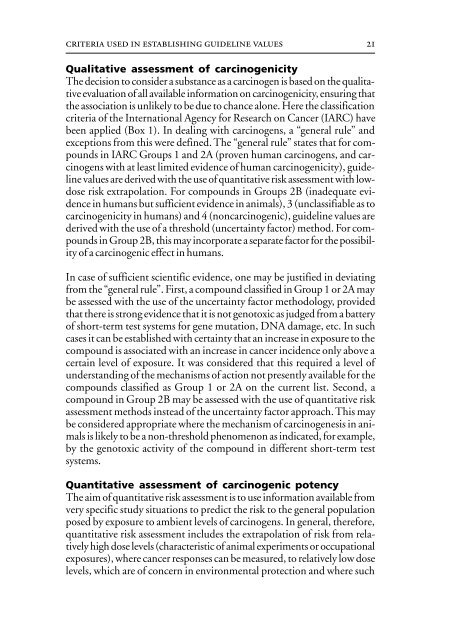Air Quality Guidelines - World Health Organization Regional Office ...
Air Quality Guidelines - World Health Organization Regional Office ...
Air Quality Guidelines - World Health Organization Regional Office ...
Create successful ePaper yourself
Turn your PDF publications into a flip-book with our unique Google optimized e-Paper software.
criteria used in establishing guideline values<br />
Qualitative assessment of carcinogenicity<br />
The decision to consider a substance as a carcinogen is based on the qualitative<br />
evaluation of all available information on carcinogenicity, ensuring that<br />
the association is unlikely to be due to chance alone. Here the classification<br />
criteria of the International Agency for Research on Cancer (IARC) have<br />
been applied (Box 1). In dealing with carcinogens, a “general rule” and<br />
exceptions from this were defined. The “general rule” states that for compounds<br />
in IARC Groups 1 and 2A (proven human carcinogens, and carcinogens<br />
with at least limited evidence of human carcinogenicity), guideline<br />
values are derived with the use of quantitative risk assessment with lowdose<br />
risk extrapolation. For compounds in Groups 2B (inadequate evidence<br />
in humans but sufficient evidence in animals), 3 (unclassifiable as to<br />
carcinogenicity in humans) and 4 (noncarcinogenic), guideline values are<br />
derived with the use of a threshold (uncertainty factor) method. For compounds<br />
in Group 2B, this may incorporate a separate factor for the possibility<br />
of a carcinogenic effect in humans.<br />
In case of sufficient scientific evidence, one may be justified in deviating<br />
from the “general rule”. First, a compound classified in Group 1 or 2A may<br />
be assessed with the use of the uncertainty factor methodology, provided<br />
that there is strong evidence that it is not genotoxic as judged from a battery<br />
of short-term test systems for gene mutation, DNA damage, etc. In such<br />
cases it can be established with certainty that an increase in exposure to the<br />
compound is associated with an increase in cancer incidence only above a<br />
certain level of exposure. It was considered that this required a level of<br />
understanding of the mechanisms of action not presently available for the<br />
compounds classified as Group 1 or 2A on the current list. Second, a<br />
compound in Group 2B may be assessed with the use of quantitative risk<br />
assessment methods instead of the uncertainty factor approach. This may<br />
be considered appropriate where the mechanism of carcinogenesis in animals<br />
is likely to be a non-threshold phenomenon as indicated, for example,<br />
by the genotoxic activity of the compound in different short-term test<br />
systems.<br />
Quantitative assessment of carcinogenic potency<br />
The aim of quantitative risk assessment is to use information available from<br />
very specific study situations to predict the risk to the general population<br />
posed by exposure to ambient levels of carcinogens. In general, therefore,<br />
quantitative risk assessment includes the extrapolation of risk from relatively<br />
high dose levels (characteristic of animal experiments or occupational<br />
exposures), where cancer responses can be measured, to relatively low dose<br />
levels, which are of concern in environmental protection and where such<br />
21

















